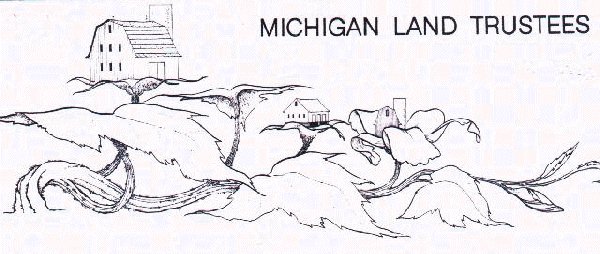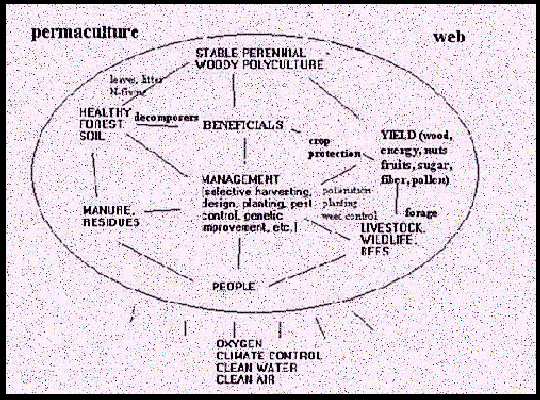
MLT Newsletter
October 1987
The Board of Directors would like to have your continued support--both
through renewal of your membership, and hopefully by your attendance at
the Annual Meeting-which will be held Sunday, November 22nd at 3 P.M.
at the Honors College on the Western Michigan University campus. The
Honors College is in the building across West Michigan Avenue from the
parking ramp. The meeting will be followed by a potluck.
The program will certainly be something special: the first formal
presentation of the permaculture program that MLT is developing for
delivery to various audiences. The permaculture program will explain
the basic concepts and visions of permaculture, why its development is
so needed now, and how those concepts are being applied in two local
settings. One, of course, is the Land Trust Farm itself; the other is
Lisa and Mike Phillips’ homestead. You will learn.about the
history of the Land Trust Farm, the current state of its permaculture
plantings, and our future plans and visions. We now have a considerable
body of both expertise and experience in permaculture, so please come
and learn more about this important approach to more ecological and
sustainable ways of growing your own food.
We look forward to your continued support and to seeing you at the Annual Meeting.
Autumn Greetings -and with them, our annual renewal notice and call for the annual meeting.
--Kenneth Dahlberg, Chairman of the Board
ThE ANNUAL MEETING OF THE MICHIGAN LAND TRUSTEES
Sunday, November 22, 1987
Honors College, Western Michigan University
3:00——Special Program, “Permaculture: Concepts, Visions, and Applications.” Followed by discussion.
4:15——Annual Meeting. Agenda items will include:
A brief review of the past year;
Election of members to Trustee Committees;
Discussion of plans for the coming year.
5:00—— Potluck supper. Bring a dish to pass; table service and drinks will be provided.
AGRO-EVOLUTION
--Jonathan Towne
Evolution implies a change from the simple to the more complex. Just as
organisms develop more complex patterns of dealing with their
environment, so do ecosystems become more complex. as organisms evolve
to fill every niche and utilize all environmental inputs.
Only people in their quest for “progress” have imposed
simple solutions in their quest for survival. Agriculture is a
short-term solution whose success is not proven since 10,000 years is
but a blink of an eye in the survival of species.
Agriculture itself has changed. Originally it was doubtless only a
small part of the food gathering strategy of people who were limited to
h and labor and selected wild plants to use in a garden-like setting.
Today with the fossil fuel subsidy, much of agriculture has more to do
with the calibration of sprayers than with the creation of a beneficial
habitat for humanity. With the external costs of erosion, pollution,
and the loss of a healthy rural culture, it seems technology is getting
the best of us.
Permaculture is a radically new approach--an ecosystem approach, rather
than a linear approach. A climax ecosystem is the best nature has to
offer in utilizing inputs and it works. The simplistic
agri—business model is beset with waste, inefficiencies, and
byproducts in the enormous task of using petroleum to suppress nature,
which in her wisdom, abhors a vacuum.
Conventional agriculture is a linear system and can be expressed as follows:
Fossil Fuel Inputs + Soil -->tillage^(erosion,pollution)---> Crops
Attention is given to the inputs and to tillage practices. Put the
right mix of pesticides and chemical fertilizers and the appropriate
genetically manipulated seed in soil, and with good weather (they
can’ t manipulate that yet), you have a crop.
Organic farming is a circular system. Inputs are organic and it
utilizes plants that fix nitrogen. The use of livestock to recycle
nutrients is seen as necessary by many. Two components add to the
efficiency of this system. One is that plants directly and indirectly
produce their own fertilizers--that is, nutrients are recycled. The
other component is a healthy soil which is seen to produce healthy
plants with little pest problems.
Clearly, agribusiness is more concerned with the inputs while organic
farming is concerned with the soil. But in other ways these two systems
are alike. They both generally rely on a monoculture of a handful of
annuals. These plants are pioneers in terms of ecological succession
and function in natural ecosystems in quickly covering the soil
following a wound and creating conditions favorable for succeeding
perennials. Plainly, tillage and the suppression of competition are
necessary to perpetuate this system. Erosion and pollution by-products
are necessary costs. Also all monocultures are vulnerable to attack
from pests which can rise in meteoric proportions, overwhelming the
ability of predators to control them.
So what is the answer? A perennial polyculture, of course! A well
designed permaculture integrating humans and animals into a plant
system is like a climax ecosystem, an efficient user of nutrients and
inherently stable. We are, for this region, talking about some sort of
food forest. There are qualifications to this. Wes Jackson and the Land
Institute are exploring perennial polycultures of non-woody plants like
the prairies that were native to their region in Kansas. This is
appropriate for such regions, but in this area with its ample rainfall
and in the absence of fire or other forms of repression, such an area
would be succeeded by trees. Aquaculture is a very productive land use
in permaculture and doesn’t rely on trees. A stable broad scale
permaculture should have an aquaculture woven in for efficient nutrient
recycling and water use.
Anyway, as the enclosed chart indicates, a permaculture web would be
very complicated but would be largely self—sustaining. People in
the landscape would have regulatory functions such as the selective
harvesting of trees, livestock placement and tree planting. Tractors
and fossil fuel inputs would be minimized or eliminated. System
establishment is what requires the real effort, of course. This has
just begun on the Land Trust Farm.
System establishment is proceeding at the Farm with Zone II development
with a dividing fence erected, the windbreaks becoming established,
dwarf and full size nut and fruit trees being planted, and this fall
the attic room of the house being converted into a greenhouse. In Zone
III a contour belt of trees and shrubs has been established in a more
erodible area.
Evolution works subtly, and whether this experiment in
“agroevolution” succeeds won’t be apparent in the
short-term future-if it is apparent next year or in a decade, then the
experiment is too “simple” to be permaculture.
SHIVERS, SHADOWS, AND SUCH
--Swan Huntoon
I have been thinking alot about folk lore lately. I really enjoy
reading it and listening to it. I’ve read Indian legends, Norse
and Celtic lore, and Greek myths. So, in keeping with the current rage
for bio—regionalism, I have decided to develop an interest in
local folk tales. There seems to be only one problem with my new hobby,
however-—I don’t know of any local folk tales. Maybe there
aren’ t any. Maybe I ‘m not tight enough with any of the
local folks for them to share with me the humorous, wry, or fantastic
stories which abound in this area. Actually, I may never know. I
‘m just too impatient to spend the time researching local lore,
so I’ve decided to make up my own. Who’ll know the
difference? Not the locals who I really don’t know well enough to
share my stories with anyway. Everyone else will take my stories at
face value. So I’m probably safe.
Here is an example of the type of folk tale I will be creating in the future:
Last May, while I was cleaning old man Saunder’s gutters out for
him, he let slip that he knew of the location of an Indian burial
ground, in the woods just southeast of my place. It was five months
before he finally agreed to show me its exact whereabouts. Since not
many people even know of the burial ground’s existence, I felt
quite honored. On a Saturday afternoon, in the beginning of autumn, we
walked toward the woods. It was the kind of day which reminds you that
winter is not as far away as you’d like it to be. Not many of the
leaves had begun to change colors, but the sky was gray and the wind
was chilly. A short way into the woods we came to a huge heap of
deadfall which I had seen before but never had ventured beyond. The
only way past the pile of bleached limbs was over it, and an accident
could result in a broken ankle, broken leg, or much, much worse. Old
man Saunders was no longer spry, but he went over that mound like a
cat, and I followed right behind him. We made it to the other side of
the pile without mishap and I found myself in a small clearing.
Suddenly, I was struck with an overwhelming impression of death. There
was no movement, no sound, no sense of life. The most readily
identifiable scent on the chill air was that of decay. The clearing was
empty, save for one thing. An ancient pine tree stood almost at the
center of the oddly lopsided expanse. In the gray, diffuse light all
the eldritch energy of this sepulcher seemed concentrated on that elder
sentinel.
Something fantastic and macabre happened long ago in the Indian burial
ground located in the woods just southeast of my place. I’ll let
you know what it was-just as soon as I make it up.
We hope you are enjoying the art work of the Newsletter. We have a new
contributor, Wendy Romano. Wendy is an elementary school art teacher in
Kalamazoo.
Due to a crowded July Newsletter.we did not include the notice of an
important event --the wedding of Rhonda Sherman and Swan Huntoon June
20th. They now live on a “mini-farm” next to Lisa and Mike
Phillips in the Lawton area. We wish them many years of happiness and
peace on their land.
This invitation is a bit early-but the Kaufman’s are having a
Christmas potluck party Saturday night, December 26, at 8 P.M. for MLT
people and Organic Growers. Please come, bring a snack and a drink, and
celebrate the holidays with us.
To make the meeting time simpler for our members the Board decided to
establish a regular date for MLT meetings, so starting in January they
will be on the third Sunday of the odd numbered months (January, March,
etc.)
The January meeting will be at Ken Dahlberg’s. The meeting will be at 3 P.M., followed by a potluck at 5.
For information on future meeting places call Ken, or Jon and Bobbi on the Land Trust Farm, 427-8791. Make a habit of MLT!
And we’ll see you at the Annual Meeting November 22nd.
Happy Halloween!
——Sally Kaufman, editor
Back to MLT Newsletter Page


